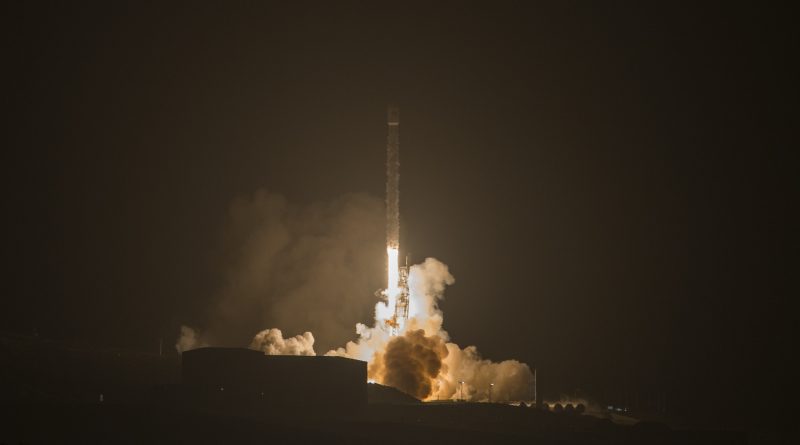Falcon 9 Delivers 3rd Iridium-NEXT Satellite Batch, 1st Stage Masters Nighttime Drone Ship Landing
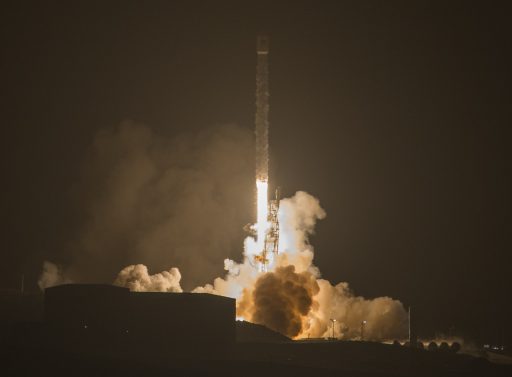
Continuing to move at a brisk pace through launch manifests on both coasts of the United States, SpaceX successfully launched a Falcon 9 rocket on Monday, thundering off from California’s Vandenberg Air Force Base before sunrise to dispatch the third group of Iridium-NEXT communications satellites into orbit. The early-morning blastoff came just over 48 hours before the planned East Coast launch of a Falcon 9 tasked with deploying the SES 11 broadcasting satellite.
Liftoff from SLC-4E occurred at 12:37 UTC, 5:37 a.m. local time and Falcon 9 completed a flawless orbital delivery taking over 70 minutes to complete while the first stage’s round-trip time from the edge of space was only a mere 7.5 minutes, succeeding in a powered landing on SpaceX’s ‘Just Read The Instructions’ Drone Ship.
The factory-new Falcon 9 Block 4 rocket was tasked with lofting a total payload upmass of 9,600 Kilograms into a 625-Kilometer orbit, requiring a two-burn profile to ferry the ten Iridium-NEXT satellites to their planned destination in space. Falcon 9 fired its nine first stage engines for 144 seconds before the two stages parted ways with Stage 1 making a backflip and re-lighting its engines to maneuver to the Drone Ship and the MVac-powered second stage heading off into orbit with an initial burn of six and a half minutes.
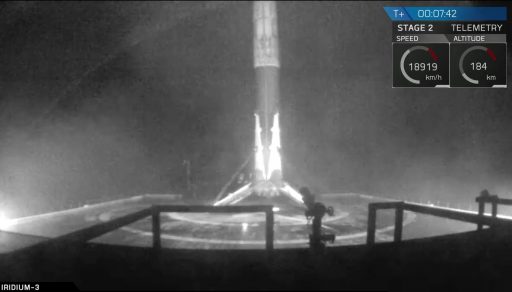
Employing the well-established three-burn return profile, the 47-meter tall booster managed to pin-point the JRTI Drone Ship some 244 Kilometers south of the Vandenberg launch site, touching down under the power of its center engine seven and a half minutes after liftoff. Booster #1041, returning in a comparatively benign re-entry environment, is a prime candidate for a re-use mission in the not-too-distant future.
Out to earn the money on Monday was the second stage, coasting for half a lap around the planet after reaching orbit and re-starting its engine to circularize the orbit ahead of dispatching the ten Iridium-NEXT satellites in a one-by-one fashion. Checking off its third mission in support of Iridium-NEXT, SpaceX is set for another five Iridium deployment flights to lift a total of 75 satellites into orbit to replace the entire heritage system in what is considered the largest satellite constellation upgrade in history.

Monday’s launch marked the 42nd flight of the Falcon 9 family, the 22nd in the Full Thrust configuration and the third of a full Block 4 vehicle. It was the 14th success of the year for SpaceX, continuing to push the company’s record for most missions conducted in a calendar year. The successful landing of the first stage brought SpaceX’s overall record to 17 successful recoveries out of 22 tries, 9/14 for ocean-based recoveries; it was the fourth successful recovery in the Pacific Ocean and the 13th successful booster landing in a row.
The replacement of the entire Iridium constellation comes with a price tag of around $2.9 billion to the Virginia-based communications company, including around $800 million for Falcon 9 launch services and ground infrastructure upgrades. The Iridium constellation – much of which had been in operation since the late 1990s – was in dire need for replacement when the first batch of ten satellites went up in January as no more orbital spares were available to patch gaps left by failures on the aging satellites. A second group of ten satellites was orbited in June and Iridium hailed the performance of the new spacecraft that offer much higher capacity than its predecessors and add a unique capability of real-time maritime and aeronautical tracking on a global scale, offering access to new markets for Iridium and cooperating companies.
The Iridium constellation is serving close to a million customers at the moment, spread across a number of sectors including the U.S. military, oil & gas companies, transportation firms and aviation / maritime operators.
>>Iridium-NEXT Satellite & Constellation Overview
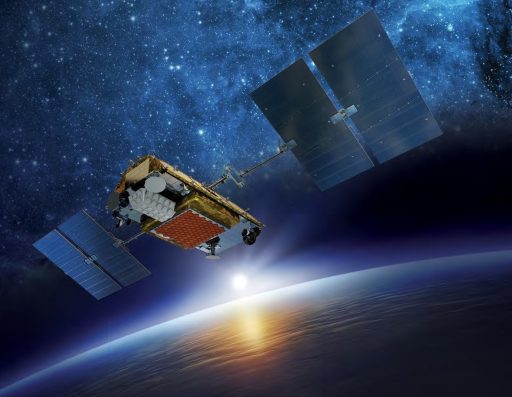
Iridium awarded the contract for the Iridium-NEXT constellation to Thales Alenia space, tasked with building 81 NEXT satellites – 75 of which are headed to orbit to replace the 66-satellite constellation and pre-position nine spares to be ready to take over at short notice in case an active satellite runs into problems. The six remaining satellites will be kept in storage to be ready for launch when needed in order to extend the life of the new constellation over at least 15 years. Orbital ATK was sub-contracted for the integration of the Iridium-NEXT satellites, establishing an assembly line at the company’s Arizona facility.
Each member of the constellation weighs 860 Kilograms at launch and hosts a powerful communications terminal covering a 4,700-Kilometer footprint on the ground with its L-Band phased array antenna to accept/send data packets which are then relayed to their destination through Ka-Band cross links between neighboring satellites.
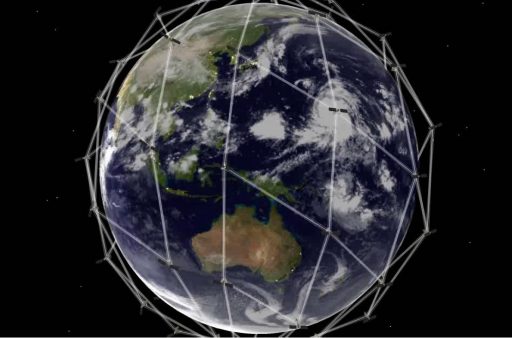
Services provided by Iridium-NEXT range from telephony over short-burst data delivery all the way to newly introduced high-capacity services with data speeds up to 8 Mbit/s realized via Ka-Band up/downlinks not possible with the heritage constellation. Iridium recently announced that the company’s new Certus service had entered in-orbit testing, promising to deliver high-bandwidth services like Internet connectivity and HD video distribution to ships, aircraft and other mobile users with data speeds up to 1.4 Mbit/s.
Iridium-NEXT satellites also facilitate hosted payloads dedicated to tracking global ship traffic via the Automatic Identification System and air traffic via the ADS-B transponders installed on commercial aircraft. The layout of the Iridium constellation for global communications coverage also enables the hosted payloads to collect real-time data on ship and aircraft movements on a global scale. Iridium operates eleven active satellites in six orbital planes, flying 780 Kilometers in altitude at an inclination of 88° to create true global coverage.
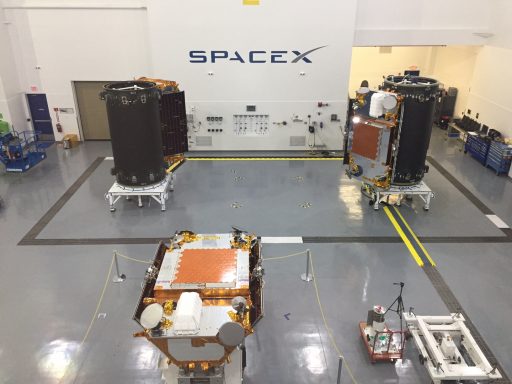
Iridium reported that satellite production is on track to support the deployment of the entire NEXT constellation by mid-2018, requiring another four Falcon 9 missions with ten satellites and one ride shared between five NEXT satellites and a pair of GRACE-FO satellites dedicated to a study of Earth’s gravity field under a joint German-U.S. project. Provided SpaceX can keep up its planned West Coast manifest, Iridium hopes to complete the constellation replacement by the end of next year.
The launch campaign leading up to Iridium-NEXT Flight 3 was fairly smooth sailing as the first two missions established the satellite processing procedure with launch vehicle processing also becoming closer to routine after five previous Falcon 9 missions from Vandenberg. The satellites shipped out in August and September to undergo final checks, take their slots on the two-tier launch adapter and receive their dose of Hydrazine maneuvering propellant. A minor five-day slip to the launch date occurred when second stage processing ran out of schedule margin, pushing the launch from an initial October 4th target.
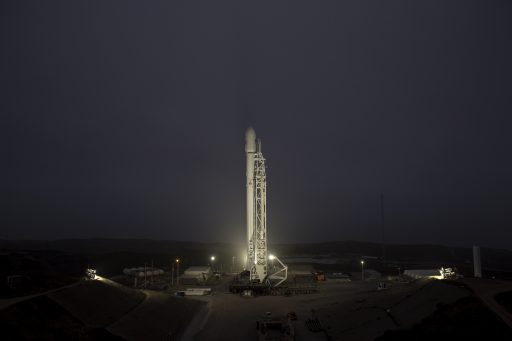
Falcon 9 fired up its first stage early on Thursday as part of the standard Static Fire test before returning to the hangar to meet its payload. The two-stage rocket returned to the pad around noon on Sunday, taking its vertical launch position for an overnight countdown operation picking up with the activation of the launcher for a detailed set of checkouts to verify readiness for propellant loading.
With Falcon 9 receiving a clean bill of health and weather showing a 90% chance of acceptable conditions, all stations provided a ‘Go’ to press into the fast-paced automated countdown sequence. The auto script kicked in at the T-1-hour mark and Falcon headed into fueling, starting with loading some 155 metric tons of Rocket Propellant 1, chilled to -7°C, into the two stages of the rocket. Liquid Oxygen, sub-cooled to -207°C, began flowing into the first stage at T-35 minutes followed by rapid LOX loading on the second stage at T-20 minutes to provide Falcon 9 with around 360 metric tons of oxidizer.
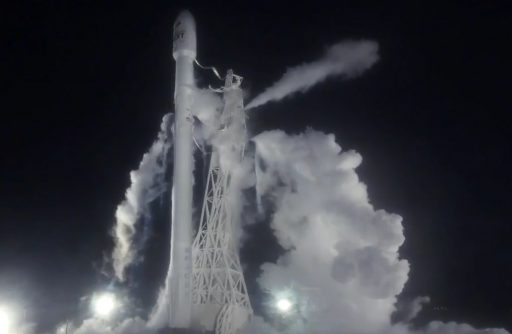
Tanking was still in full swing when Falcon 9 began executing its fast-paced final countdown phase at T-7 minutes, starting with the chilldown of the nine Merlin 1D engines followed in close succession by final checks of engine trim valves and thrust vector control actuators, the transfer to internal power and the retraction of the Strongback structure to clear the path uphill. Reaching the one-minute mark, Falcon 9 had armed its Autonomous Flight Termination System and control was handed off to the rocket’s onboard computers to oversee the final pressurization of tanks and the critical ignition sequence.
Ignition of the nine Merlin engines was commanded at T-3 seconds and Falcon 9 roared to a launch thrust of nearly 700 metric ton force for liftoff at the precise time of 12:37:01 UTC, the instant Vandenberg was carried into Plane 4 of the Iridium constellation by Earth’s rotation.
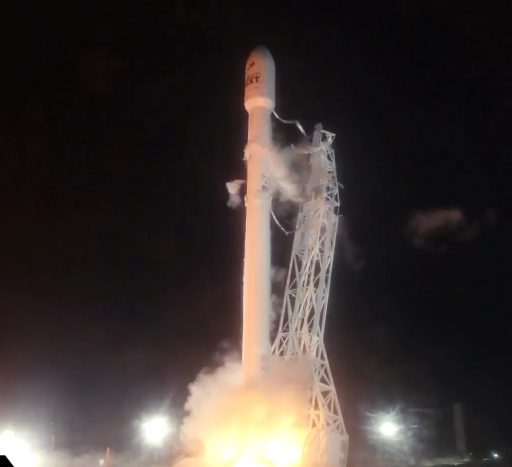
Lighting up the night, Falcon 9 rose vertically for the first 20 seconds of the flight before beginning its pitch-over to get aligned with a trajectory taking it due south in order to reach an orbit inclined 88.66°. Burning 2,500 Kilograms of propellant per second, the nine Merlin 1D engines pushed the vehicle to the speed of sound in just over a minute with a brief throttle-down around T+69 seconds when the vehicle was heading through the area of Maximum Aerodynamic Pressure on its way out of the dense atmosphere.
The first stage concluded its role in the day’s ascent mission two minutes and 24 seconds after launch when shutting down its engines, having accelerated the vehicle to a speed of 1.93 Kilometers per second, or around a quarter of what is needed to achieve orbit. Separation of the stages via pneumatic pushers occurred four seconds after MECO some 66 Kilometers in altitude with the second stage heading into start-up mode and the first stage firing its cold gas thrusters to rapidly flip around and begin its return to Earth.
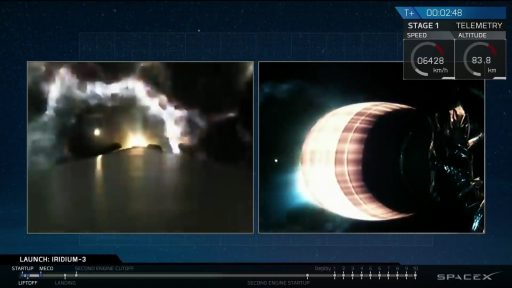
With knowledge gained over the initial booster recovery attempts & upgrades to the thruster system and flight controls on the first stage, SpaceX was able to significantly tighten the interval between stage separation and the boostback maneuver. In fact, boostback missions now use the center engine to finish the flip maneuver to limit the downrange travel distance to a minimum – particularly important for missions aiming for a full reversal to land on shore. Re-start of the center engine occurred two minutes and 40 seconds after launch and two outer engines joined five seconds later when the booster had leveled off, thrusting toward the velocity vector.
After the 32-second boost back, the first stage entered two and a half minutes of exospheric flight, climbing to an apogee of 107 Kilometers before dropping back toward Earth, in the process deploying its four aerodynamic grid fins and re-orienting for the entry burn.
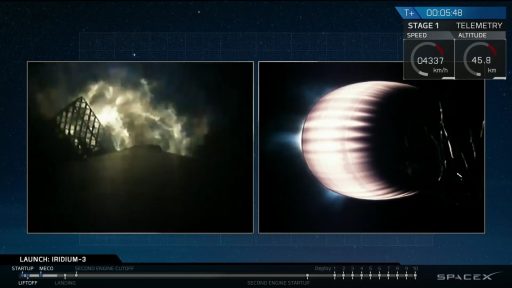
The 13-second Entry Burn commenced five minutes and 43 seconds into the flight, employing a trio of Merlin engines to slow the booster by 356 meters per second and set the course toward the Drone Ship.
The grid fins came into play after conclusion of the Entry Burn, controlling the booster’s flight path toward the ASDS and setting the proper angle of attack for atmospheric descent. As a LEO mission, Monday’s booster return enjoyed plenty of propellant margin that allowed for a single-engine landing maneuver, the preferred method as it allows more time for course corrections and finer control of the touchdown speed. Firing up the center engine around 30 seconds before touchdown, the booster successfully arrested its vertical speed and set itself down on four fold-out landing legs that deployed in the closing seconds of the decent.
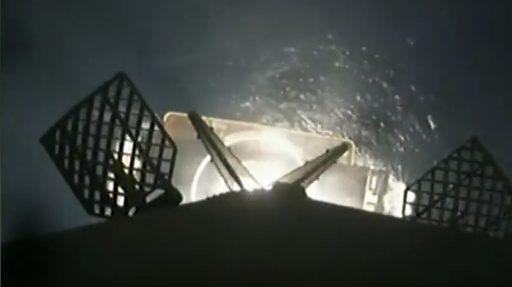
Mastering a bullseye landing on ‘Just Read The Instructions’ the Falcon 9 booster needed 7 minutes and 21 seconds for its trip to the edge of space and back. Initial safing was to be completed remotely before engineers could re-board the drone ship to tie the booster down for its trip to the Port of Los Angeles, marking the first step toward re-flight.
In charge of the primary mission, the Falcon 9 second stage fired its 95,000-Kilogram-force MVac engine for six minutes and 25 seconds to lift the stack into an elliptical parking orbit, shedding the payload fairing three minutes and 14 seconds into the mission when crossing 115km in altitude. Shutdown of the upper stage nine minutes after blastoff marked the mission’s transition into a 43-minute passive flight phase to allow the second stage to make half a lap around the globe and, in the process, climb up to the high point of its orbit at around 633 Kilometers so that the brief engine re-start could act as a circularization maneuver.
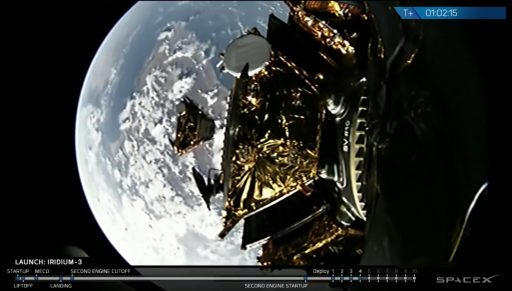
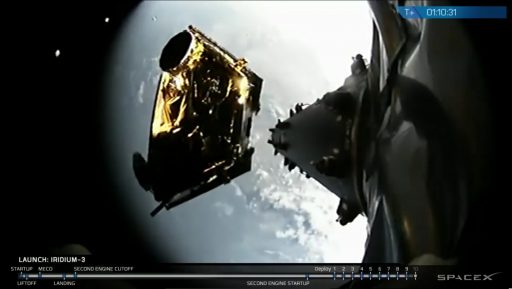
While coasting, the second stage crossed the Pacific, flew over Antarctica and entered a leg to the north, passing over the Indian Ocean and reaching the range of a tracking station on Madagascar. The MVac engine re-started 52 minutes and four seconds into the flight, firing for just three seconds to accelerate the stack by 120 meters per second and lifting the perigee of the orbit to reach the staging and maintenance orbit of the Iridium constellation.
Arriving at its orbital destination, the second stage pitched down before initiating the sequential satellite separation sequence with one Iridium-NEXT satellite pushing off the two-tier adapter every 100 seconds, starting 57 minutes into the mission. SpaceX Launch Control called out all ten deployments in near real-time, marking the completion of Falcon’s primary mission.
Unlike the first two Iridium-NEXT launches, there will be no drifting for the satellites delivered on Monday as all are headed directly into operational spots within Plane 4 of the constellation. All ten satellites checked in with ground stations, Iridium confirmed via Twitter. They are now set for a multi-week activation and checkout campaign to verify their space-to-ground and inter-satellite links before phasing into the operational constellation 780 Kilometers in altitude for instantaneous slot-swaps with retiring first-generation satellites.
Iridium is aiming for another launch before the end of the year, currently targeting late November in order to cross the 50% mark for constellation satellites sent into orbit on a path to having all satellites in orbit by mid-2018 so that all constellation satellites can be replaced by the end of next year.

